

ICDE Global Quality in Online Open Flexible and Technology Enhanced Final REPORT 2018. Instructional Design in Higher Education Annotated Bibliography. Instructional Design in Higher Education Defining an Evolving Field. 25 Strategies to Engage Students on Your Next Zoom Meeting – Hooked On Innovation. Now that we have all been thrust into the world of online learning, we have to figure out ways as educators to engage our students when they are online.

Some of the first things schools did when shifting to remote learning was to hold regular video meetings with their students. These can vary based on the ages of the students and the frequency of when a teacher interacts with their students, but most teachers realized quickly that they can’t use the same behavioral strategies (like proximity) that they use in a physical classroom. This can lead to a lack of student engagement and involvement in what is trying to be taught regardless of age.
These 25 strategies listed here are not meant to take the place of deeper learning. That kind of learning is generally better when done with a mix of asynchronous learning. 1. I’m going to start out with one of the basics. 2. Of course, if you don’t want to share your screen you can always use the built-in whiteboard feature that comes with Zoom. 3. 8 New Ideas for Engaging Online Students. For many adults, taking a class online is a new learning experience.
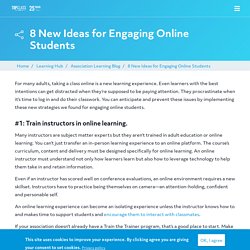
Even learners with the best intentions can get distracted when they’re supposed to be paying attention. They procrastinate when it’s time to log in and do their classwork. You can anticipate and prevent these issues by implementing these new strategies we found for engaging online students. Lesson Plans That Increase Student Engagement Online. Ten Ways to Overcome Barriers to Student Engagement Online (Academic Technology: At the College of William and Mary) How to Be a Better Online Teacher. 10 Best Practices To Be An Effective Online Teacher.
The digital classroom brings with it a range of unknown and unexplored territory, mostly in part to its relative newness when compared to traditional teaching methods.
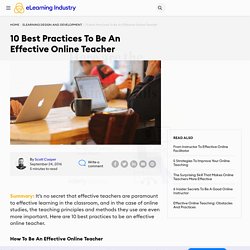
To be an effective online teacher, there are 10 simple but effective practices you can follow. When coupled with a comprehensive course load and the right resources, there’s no reason why online learning can’t be even more effective than a traditional classroom setting. 1. Be Present Sure, you might not be physically present in a classroom, but there are many ways to make yourself known in the digital realm. 2. 5 Ways to Connect With Online Students. I’d been teaching online courses for 10 years — and, I liked to think, had become quite efficient and effective in the format — on the day it dawned on me that I was treating my online students as if they weren’t actually people.

Most of my university’s courses, in normal times, are offered in buildings, not online, and I teach in both realms. My epiphany came in March 2018, when a student I’ll call “Lori” emailed to explain why she hadn’t followed directions on an assignment. I’d required students to submit a quick video of themselves, but she’d posted an audio with her photo attached. In the week before the due date, she explained, she’d been beaten up by an ex-boyfriend. Liberating Structures - 11. Shift & Share. Shift & Share Spread Good Ideas and Make Informal Connections with Innovators (90 min.)
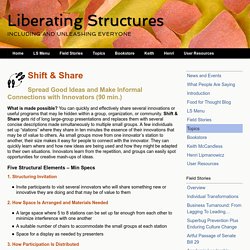
What is made possible? You can quickly and effectively share several innovations or useful programs that may lie hidden within a group, organization, or community. Shift & Share gets rid of long large-group presentations and replaces them with several concise descriptions made simultaneously to multiple small groups. A few individuals set up “stations” where they share in ten minutes the essence of their innovations that may be of value to others. Five Structural Elements – Min Specs 1.
Liberating Structures - 8. Troika Consulting. Troika Consulting Get Practical and Imaginative Help from Colleagues Immediately (30 min.)

To listen is very hard, because it asks of us so much interior stability that we no longer need to prove ourselves by speeches, arguments, statements or declarations. True listeners no longer have an inner need to make their presence known. They are free to receive, welcome, to accept. – Henri Nouwen What is made possible? Five Structural Elements – Min Specs 1.
Invite the group to explore the questions “What is your challenge?” Liberating Structures - 13. Wise Crowds. Wise Crowds Tap the Wisdom of the Whole Group in Rapid Cycles (15 min. per person) Every journey has a secret destination of which the traveler is not aware. – Martin Buber What is made possible?
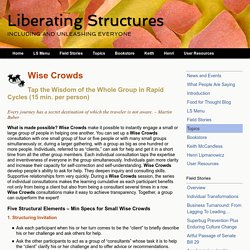
The Art of Facilitating Virtual Discussion Groups and Breakouts. One of the best community experiences I’ve ever had was a weekly lunch hosted at a small indie coworking space where I was a member.
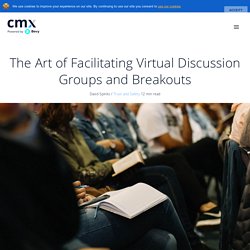
Every Wednesday, we’d sit down for lunch and have a facilitated 90-minute discussion. The format was simple: we’d go around and each share a high and low from our week for the first 45 minutes, then switch to a shared discussion on a single topic.